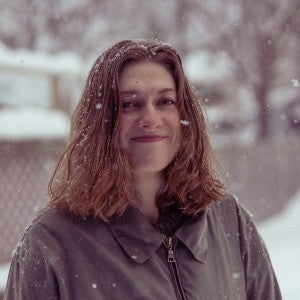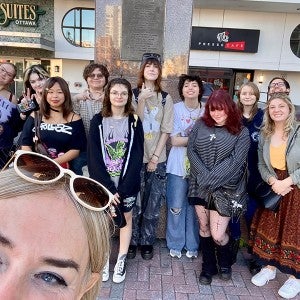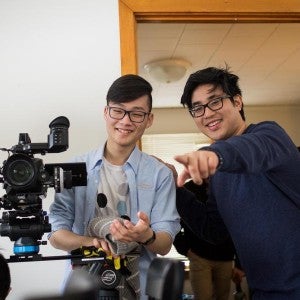Planting the seeds: Greenacres documentary project launches with research, exploration, and hands-on learning
Director of Film & New Media Michael Mittelstaedt shares an update on the Greenacres documentary project.
At an age when many aspiring filmmakers are just beginning to explore visual storytelling, Interlochen Arts Academy’s Film & New Media students are collaborating on a significant professional project: A feature-length documentary on regenerative agriculture.
“In my knowledge, there’s no other high school doing anything like this,” said Director of Film & New Media Michael Mittelstaedt. “This is not simply an exercise: It’s an opportunity to create a piece of work on an incredibly important topic that is going to be seen by very many people.”
The documentary, which is being produced in partnership with the Ohio-based Greenacres Foundation, began production this fall under the guidance of experienced filmmakers Nathan Buck, Claire Collins, and Lydia Marie Hicks. Over the next several years, students will work closely with Interlochen faculty, members of the Greenacres team, and local partners to learn more about regenerative agriculture, create the film, and share it with audiences across the world—all while honing their skills as storytellers.
“This project gives students a glimpse of what it might be like to be a professional filmmaker,” Mittelstaedt said. “To me, it’s a way of entrusting students to be partners in their own learning.”
Delving into documentary
Before beginning production, students examined how making a documentary differs from creating a narrative fiction film.
“During the first part of the semester, we started thinking about what it means to tell a nonfiction story,” Mittelstaedt said. “We began by learning about how we gain information in a nonfiction space and how to conduct an interview without leading the subject. They learned how to craft questions and think about the subject as a partner in telling the story—rather than just extracting the information, using it, and acting as if this is our story, as opposed to the story of the people we are interviewing.”
Students practiced these techniques by conducting interviews with members of Interlochen’s Sustainability team. Each pod of students researched their assigned team member, crafted interview questions based on the subject’s expertise, and recorded an on-camera interview.
For the Film & New Media division—which has historically emphasized narrative fiction—the documentary project is an opportunity to explore a different genre and take an alternate approach to teaching the elements of storytelling.
“Working on a documentary is refreshing in some ways, because it takes the burden of inventing a story off of the student,” Mittelstaedt says. “Telling true stories is important for them academically, because it continues to hone their storytelling skills. They still have to engage audiences and keep them interested. They still have to think about dramatic storytelling, the arc, and the characters. We’ve created a space where students can think openly about being a documentarian and how you tell a story that is dramatic and interesting, but also has to be the truth. Those questions are huge—especially when you begin to tackle them at this stage of life.”
Beyond the artistic and technical considerations, the process of documentary nurtures students’ development as empathetic creatives.
“They’re beginning to turn the corner, maybe earlier than most other students, from looking at themselves to being able to see someone else’s point of view and tell stories on behalf of other people,” Mittelstaedt said. “I think that’s beneficial to them both as filmmakers and as human beings.”
Cultivating relationships
While students spent most of the semester engaged in classroom work, Buck, Collins, and Hicks began identifying potential story partners in both the Grand Traverse region and beyond.
“These past few months have been the ‘research and development’ phase of the documentary,” Mittelstaedt said. “We’ve been looking at who the players in regenerative agriculture are in our area, how they are interrelated, and how we can start the conversation. Nathan [Buck], Lydia [Hicks], and Claire [Collins] are working in a way that is very student-focused as they begin to procure our story partners. They’re looking for information locally by asking questions such as, “Who’s most accessible? How can we find representatives in science and represent inclusive communities?”
Story partners are critical to the documentary’s impact, providing a human perspective on a complex subject.
“The data and ‘talking heads’ are not going to create a compelling story,” Mittelstaedt said. “What’s really going to resonate with audiences is watching somebody turn a page in their agricultural practice, work through that struggle, and emerge into a place where they are producing better food—thereby producing better community.”
The Greenacres Foundation is one of the documentary’s most important story partners. In October, Buck, Collins, and Hicks—accompanied by Mittelstaedt and Director of Sustainability Emily Umbarger—traveled to Cincinnati, Ohio to meet with Greenacres Foundation President Carter Randolph, Ph.D. and Executive Director Meredith Leslie and learn more about the foundation’s work.
“[Randolph and Leslie] gave us a tour of all the amazing things they’re doing at Greenacres to better understand regenerative agriculture and ways we might be able to practically apply these types of techniques and use them in a scaled-up version around the world,” Mittelstaedt said. “We were also able to see a presentation by Dr. Stephan van Vliet, a research scientist who is looking into the differences in nutrition between products produced at a conventional farm versus a Greenacres farm.”
The Interlochen delegation also met with Greenacres researchers to discuss plans for the film.
“It was an opportunity for us to get to know their science team, have some conversations with them about the documentary, and share how, in a dynamic way, the faculty and students are working together to create the documentary itself,” Mittelstaedt said.
Film & New Media students joined the faculty collaborators for a second off-site visit: A trip to the Michigan State University AgBioResearch Center in Lake City, Michigan.
“MSU is helping support the Greenacres Foundation’s research with cattle and how grazing on regenerative grasses and feed can improve the health of the animals—thereby improving the health of the people who consume them,” Mittelstaedt said. “The whole process is grass-fed, and the grass is being grown on soil that has been regeneratively increased over time.”
Introspection and advocacy
As students continue their exploration of agriculture and sustainability, the faculty have challenged them to examine their own food consumption habits.
“Over Thanksgiving break, we asked students to look at food sources in their own homes and what the relationship with food is like within their families,” Mittelstaedt said. “Since we have students from incredibly diverse locations, we were able to see how those relationships are different or similar—especially as many of them celebrated Thanksgiving, which is a very food-centric holiday. This assignment was another step towards finding ways that students can understand both the ecology of farming and what it means to reflect a true story.”
The Thanksgiving holiday also created space for students to engage in generative conversations with their loved ones.
“It’s been curious to see the students mindfully confront people who aren’t familiar with regenerative agriculture and offer them the opportunity to think about it in a way that invites them into the conversation—which is essentially what the documentary will do,” Mittelstaedt said. “We’re seeing a lot of the students make these discoveries inside of the class. They’re thinking about—as individuals are going to inherit the processes and problems we are creating now—what their investment is and what stake they have in this conversation.”
“They’re super capable students, and incredibly intelligent,” Mittelstaedt continued. We’re learning, together, about a topic that none of us are experts in, sharing those ideas across several generations, and thinking about the answers to the questions that we have.”
Seasons of storytelling
As the fall semester draws to a close, the docmuentary’s development echoes the cadence of life in northern Michigan.
“We have the exciting opportunity to think about this project in the stages of seasons,” Mittelstaedt said. “As we come into winter now, we think about dormancy and the rebirth of creatures and plants in the spring. When we return in January, our intent is to define the ‘threads’ of the story and begin to coordinate capturing those threads.”
“We’ll have roughly three pods of students who will be tasked with finding more information—whether around the area or at Greenacres,” Mittelstaedt continued. “Our hope is to have a larger trip, with the whole class, to Greenacres in the spring. We’ll begin principal photography, identifying the people we’re going to be interviewing, and getting out there to produce this work.”
While the film’s themes are still being defined, the team has already begun planning a series of events that will accompany the film’s screenings.
“We’d like to write this piece future-forward,” Mittelstaedt said. “When the film comes out, our intention is to share it around the world in a way that creates a sustainable space and builds community. As the audience comes out of the theatre, they’ll be met by some of their food providers and a local chef who will prepare a meal for them that will allow them to meet other members of their community.”
“The hope is not simply to tell people about practices they might use, but also to engage them in their community so it facilitates the adoption of regenerative agriculture,” Mittelstaedt continued. “These events will move audiences from seeing something challenging about the way the world is and leaving feeling a little vacant, to meeting someone new and learning how they can help.”
“The ‘sequel’ to this film is each member of the audience beginning to think about where they fit into our obligation to the planet and to sustainability.”





